Best Study Material for Electronics and Communication Engineering (ECE) Exam
Electronics and Communication Engineering (ECE) Exam > Electronics and Communication Engineering (ECE) Notes > Analog Circuits > Op-Amp and Differential Amplifier
Op-Amp and Differential Amplifier | Analog Circuits - Electronics and Communication Engineering (ECE) PDF Download
Introduction
- Op-Amp (Operational Amplifier) is a fundamental building block for handling analog electrical signals.
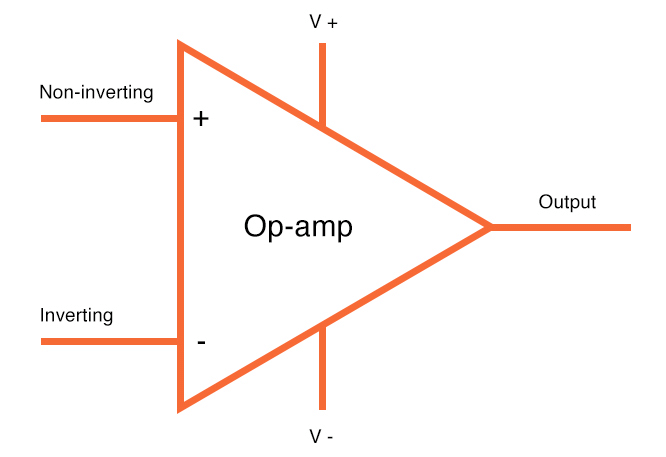
- An operational amplifier is a high gain, differential, voltage amplifier.
- OP AMP has two inputs called “+” and “-,” (or VIN+ and VIN-) and a single output.
- The output depends only on the difference of the voltage on the two inputs.
- If the difference of the two input voltages is VIN , the output voltage is VOut, then VOut = ΔVIN GV
where Gv is the (voltage) gain. - Differential operation involves the use of opposite polarity inputs.
- Common mode operation involves the use of the same polarity inputs.
- Common-mode rejection compares the gain for differential inputs to that for common inputs.
- Ideal Op Amp Attributes
- Infinite Differential Gain
- Zero Common Mode Gam
- Zero Offset Voltage
- Zero Bias Current
- Op Amp Inputs
- High Input Impedance
- Low Bias Current
- Respond to Differential Mode Voltages
- Ignore Common Mode Voltages
- Op Amp Output
- Low Source Impedance
- An ideal op-amp is usually considered the following properties, and they are considered to hold for any input voltages.
- Infinite open loop gain
- Infinite bandwidth (the frequency magnitude response is flat everywhere with zero phase shift)
- Infinite input impedance
- Zero input current (There is no leakage or bias current into the device)
- Zero input offset voltage (when the input terminals are shorted, output is a virtual ground)
- Infinite slew rate (Rate of change of the output voltage is unbounded) and power bandwidth (full output voltage and current available at all frequencies).
- Zero output impedance (Rout = 0, and so output voltage does not vary with output current)
- Zero noise
- Infinite CMRR (Common mode rejection ratio)
- Infinite Power supply rejection ratio for both power supply rails.
Question for Op-Amp and Differential Amplifier
Try yourself:Which of the following electrical characteristics is not exhibited by an ideal op-amp?
View Solution
Properties of Op-Amp
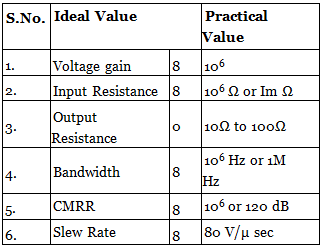
Op-Amp Classification

Differential Operational Amplifier
- A differential operational amplifier has inverting and non-inverting inputs with high input impedance and differential or open-loop gains between 1000 and 10 million.
- When the inverting input is used with negative feedback due to R0, the closed loop gain is given by (-R0 / R1) and the input impedance is R1 the output impedance is the open loop output impedance divided by loop gain.

Loop gain (dB) = Open loop gain (dB) – Closed loop gain (dB) - If a number of signals are connected to the inverting input, the output is proportional to the sum of the input signals, making possible the solution of linear algebraic and differential equations on an analog computer.
- If the non-inverting input to a differential operational amplifier is used, the input impedance is increased to a value,
Rcm || (Ri × loop gain)
where Rcm is the common mode impedance and Ri is the differential impedance. - One way to increase input impedance to an amplifier utilizing the inverting input is to reduce the feedback voltage by connecting a voltage divider at the output.
- The voltage gain for a non-inverting input is:

- A true ideal differential amplifier the difference between two input voltages providing an output,

- In practice, the output also consists of an error term that is due to the common-mode input voltage = (V1 + V2)/2.
- Total output of a differential amplifier is:


Question for Op-Amp and Differential Amplifier
Try yourself:Why differential amplifiers are preferred for instrumentation and industrial applications?
View Solution
Common Mode Rejection Ratio (CMRR)
- The common mode rejection ratio is a figure of merit of a differential amplifier, since it is the ratio of differential gain, Ad (the desired gain), to the common-mode gain AC.
CMRR = Ad/Ac
or
CMRR/dB = 20log Ad - 20log Ac - Emitter-coupled differential amplifiers are the type of circuit used predominantly in ICs, because of the manufacturing ability to closely match components, and since the devices are so closely spaced their variations due to temperature tend to cancel, providing excellent DC coupling stability.
- High values of CMRR are provided by large effective values of emitter resistance Re, in the emitter-coupled amplifier. This may be provided by a transistor or CRD to provide essentially a constant-current source in the emitter.

Ideal Voltage Transfer Curve
- The graphic representation of the output equation is shown in figure in which the output voltage V0 is plotted against differential input voltage Vd, keeping gain Ad constant.

 |
Test: Differential Amplifiers
|
Start Test |
Start Test
Non-linear Op-Amp Circuits
- Integrator
- Circuit Diagram

- Output Voltage:

- Circuit Diagram
- Differentiator
- Circuit Diagram
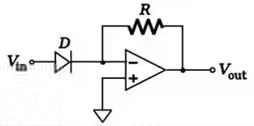
- Output Voltage:

- Circuit Diagram
- Non-Linear: Log-Amplifier
- Circuit Diagram

- Output Voltage:

- η = recombination factor, Vt = thermal voltage, and I0 = reverse saturation current of diode.
- Circuit Diagram
- Non-Linear: Anti-log Amplifier
- Circuit Diagram
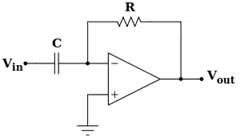
- Output Voltage:

- Circuit Diagram
Determination of Grounded Load

- If Vs is applied at point A and B grounded and

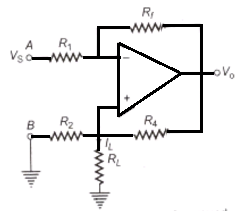 Load resistance connected to ground
Load resistance connected to ground
Capacitance Multiplier
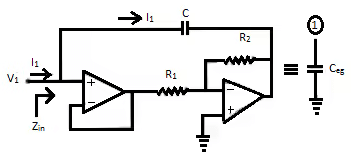 Capacitance Multiplier Circuit
Capacitance Multiplier Circuit
Equivalent capacitance:
This circuit is useful in creating artificially large values of capacitances while using low-valued C which is normally available.
Inductance Simulator
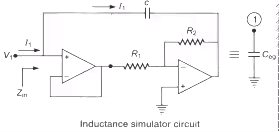

Inductance Leq = CR1R2 Henry
Quality factor: 
Non-inverting Integrator
- The circuit shown below is a non-inverting integrator, where negative feedback exists.
- The analysis will be as follows.
 or
or
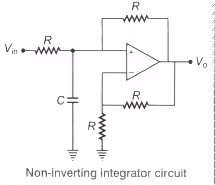
 |
Download the notes
Op-Amp and Differential Amplifier
|
Download as PDF |
Download as PDF
Non-inverting Differentiator
- It uses a single operational amplifier.
- The main feature of the circuit is that the input impedance is purely resistive.


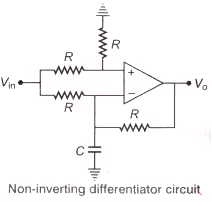
Applications of Operational Amplifiers
- Inverting Amplifier
- Non-inverting Amplifier
- Differentiator
- Differential Amplifier
- Voltage follower
- Selective inversion circuit
- Current-to-voltage converter
- Active rectifier
- Integrator
- Comparator
- Filters
- Voltage comparator
- Signal Amplifier
The document Op-Amp and Differential Amplifier | Analog Circuits - Electronics and Communication Engineering (ECE) is a part of the Electronics and Communication Engineering (ECE) Course Analog Circuits.
All you need of Electronics and Communication Engineering (ECE) at this link: Electronics and Communication Engineering (ECE)
|
3 videos|34 docs|64 tests
|
FAQs on Op-Amp and Differential Amplifier - Analog Circuits - Electronics and Communication Engineering (ECE)
| 1. What is a differential operational amplifier (Op-Amp)? |  |
| 2. How does a differential amplifier work? |  |
Ans. A differential amplifier amplifies the voltage difference between its two input terminals. It consists of two input terminals (inverting and non-inverting), and a single output terminal. The amplifier amplifies the difference between the voltages applied to its two inputs, while rejecting any voltage that is common to both inputs. This makes it ideal for amplifying small signals in the presence of noise.
| 3. What are the applications of differential amplifiers? |  |
Ans. Differential amplifiers find wide applications in various fields, including:
- Instrumentation amplifiers: They are used to amplify small signals from sensors and transducers in measurement systems.
- Audio amplifiers: They are used in audio systems to amplify and control the volume of audio signals.
- Analog-to-digital converters: They are used to convert analog signals into digital signals in various electronic devices.
- Differential signaling: They are used in high-speed communication systems to transmit signals with lower noise and better signal integrity.
| 4. How to analyze the behavior of a differential amplifier? |  |
Ans. To analyze the behavior of a differential amplifier, one can use the following steps:
- Determine the input impedance: Calculate the input impedance of the amplifier, which is the ratio of the change in voltage to the change in current at the input terminals.
- Calculate the gain: Determine the voltage gain of the amplifier, which is the ratio of the change in output voltage to the change in input voltage.
- Analyze the common mode rejection ratio (CMRR): CMRR is a measure of how well the amplifier rejects common-mode signals. Calculate the CMRR by dividing the differential mode gain by the common mode gain.
- Consider the frequency response: Analyze the amplifier's frequency response to understand its behavior at different frequencies.
- Evaluate stability and linearity: Assess the stability and linearity of the amplifier to ensure its reliable and accurate operation.
| 5. What are the advantages of using a differential amplifier? |  |
Ans. The advantages of using a differential amplifier include:
- High common mode rejection ratio (CMRR): Differential amplifiers can reject common-mode signals, making them suitable for amplifying small differential signals in the presence of noise.
- Increased signal-to-noise ratio (SNR): By amplifying the voltage difference between input terminals, the SNR is enhanced, leading to better signal quality.
- Improved linearity: Differential amplifiers offer better linearity, ensuring accurate amplification of signals.
- Higher input impedance: They provide a high input impedance, minimizing loading effects on the signal source.
- Flexibility: Differential amplifiers can be easily configured to perform different mathematical operations, making them versatile in various applications.
Related Searches




















